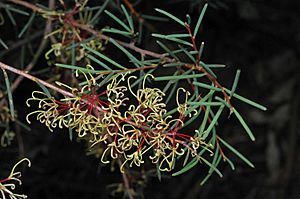Hakea commutata facts for kids
Quick facts for kids Hakea commutata |
|
|---|---|
 |
|
| Hakea commutata in the ANBG | |
| Scientific classification | |
| Genus: |
Hakea
|
| Species: |
commutata
|
 |
|
| Occurrence data from Australasian Virtual Herbarium | |
Hakea commutata is a type of shrub that belongs to the Proteaceae plant family. It grows naturally in Western Australia. This plant can look quite different depending on where it grows, from sandy areas to along creeks.
Contents
What is Hakea commutata?
Hakea commutata is a tough shrub that can be bushy or spread out. It grows from about 0.5 to 3 meters (1.6 to 9.8 feet) tall. This plant has a special woody swelling at its base called a lignotuber. This helps it regrow after a fire.
Its leaves look like needles. They are about 1 to 3.5 centimeters (0.4 to 1.4 inches) long. The leaves are bluish-green and might have a whitish, powdery coating. They can feel smooth or a bit rough.
Flowers and Fruit
The flowers of Hakea commutata grow in clusters of 8 to 12. These clusters are called an inflorescence. They appear either where the leaves meet the stem or at the end of branches.
The flowers are usually cream-white to yellow. They have a reddish tint at their base. These pretty flowers bloom from September to November, sometimes even into December.
After the flowers, the plant grows woody, brown fruits. These fruits are oval-shaped and look a bit wrinkled. They are about 2 to 3.2 centimeters (0.8 to 1.3 inches) long. Inside, there are black or dark brown seeds. Each seed has a wing on one side, which helps it fly away in the wind. It takes about 23 days for the seeds to sprout.
How it Got its Name
The plant Hakea commutata was first officially described by a botanist named Ferdinand von Mueller. He did this in 1865.
The second part of its scientific name, commutata, is a Latin word. It means "with change." Mueller chose this name because he thought the leaves of this plant varied a lot.
Where Does it Grow?
Hakea commutata is found only in certain parts of Western Australia. These areas include the Wheatbelt and Goldfields-Esperance regions. You can find it from Toodyay in the north to Fitzgerald River National Park in the southwest. It also grows in Cape Arid National Park in the southeast.
This shrub often grows along rivers and creeks. It also likes areas with granite rocks. It prefers sandy-loam or clay soils. You'll often see it as part of plant communities called mallee heath.
Is it Endangered?
The Western Australian Government's Department of Parks and Wildlife has checked on Hakea commutata. They have classified it as "not threatened." This means it is not currently in danger of disappearing.

